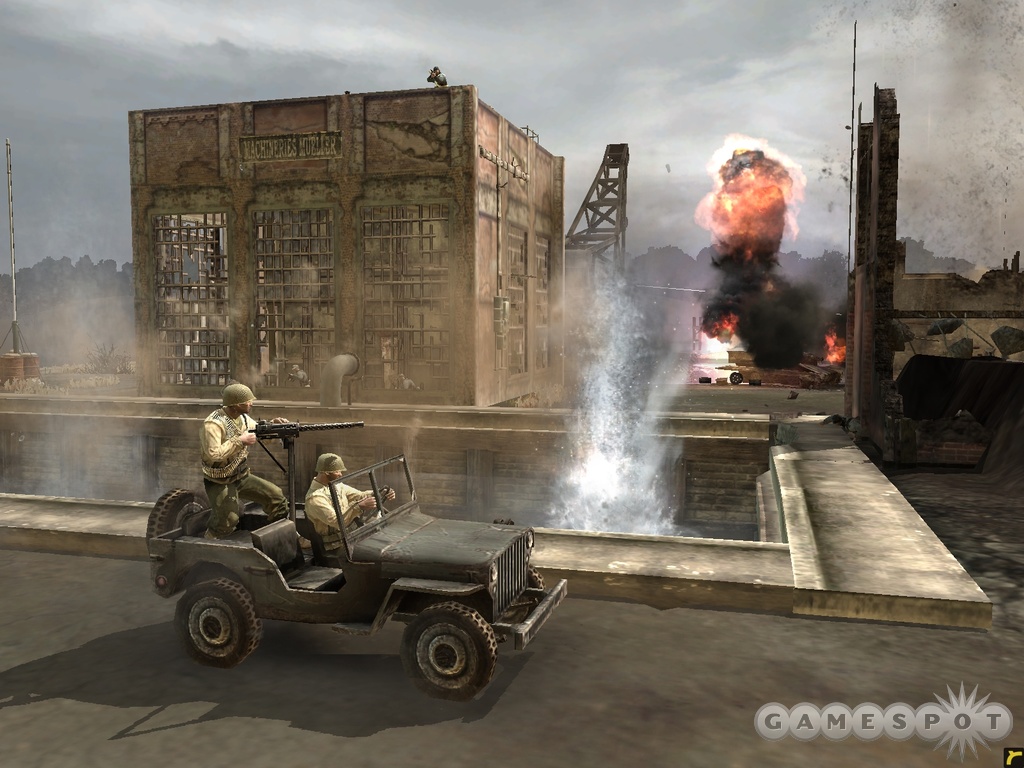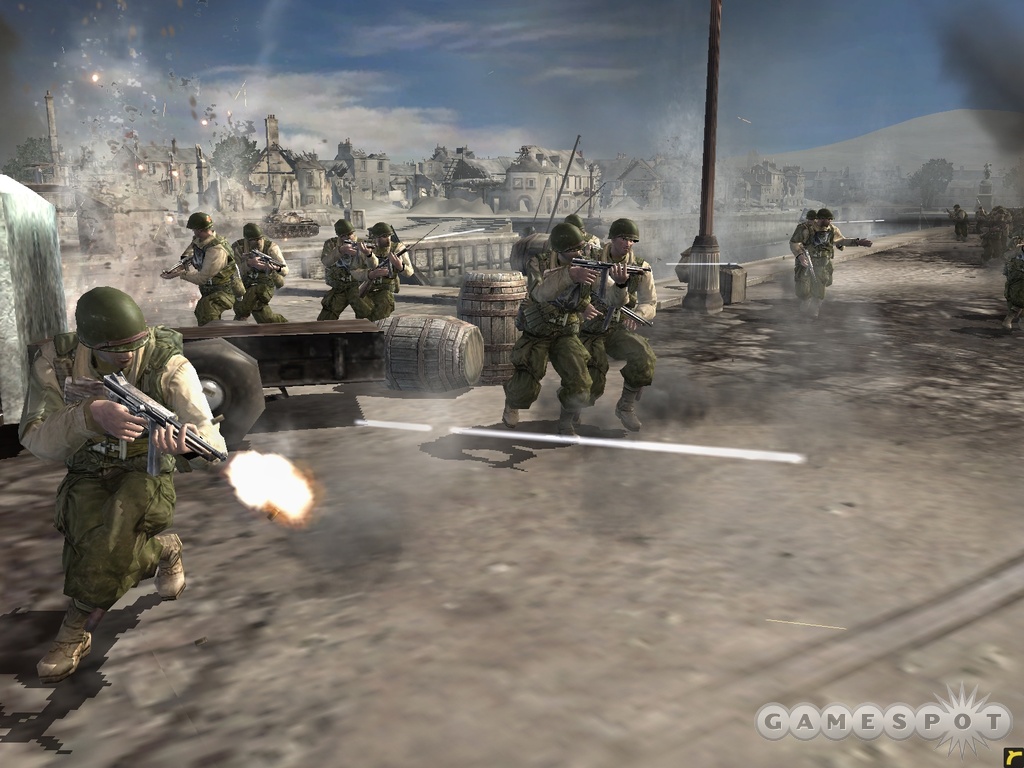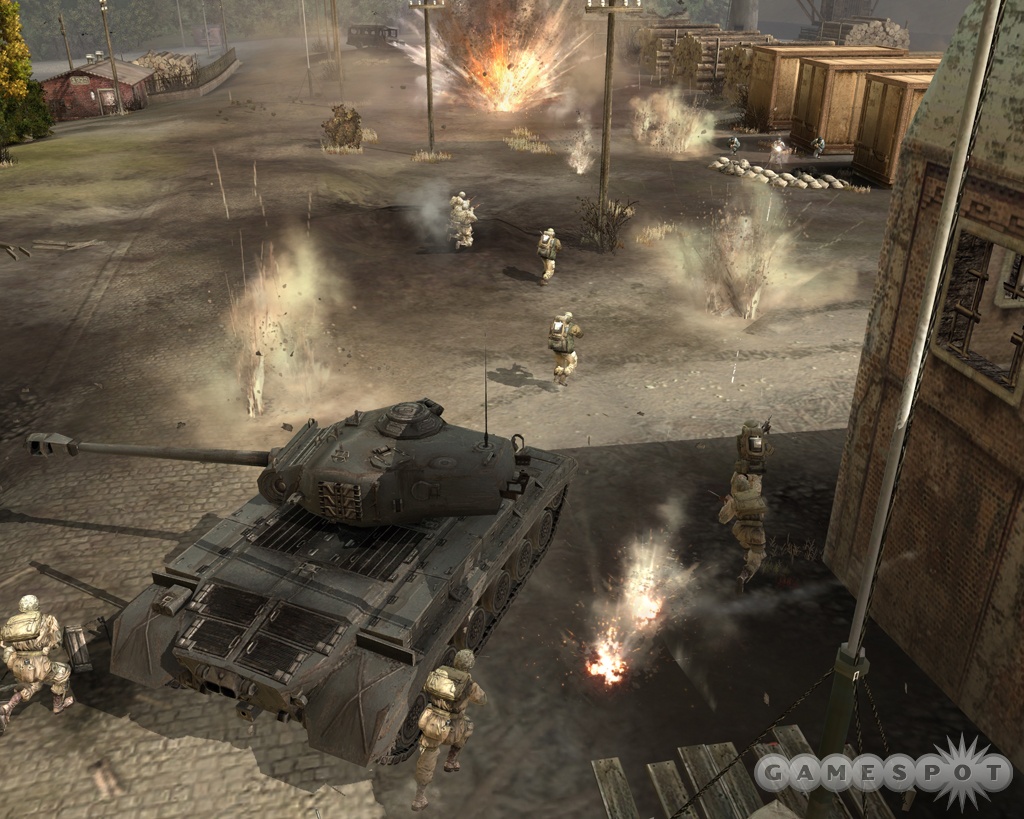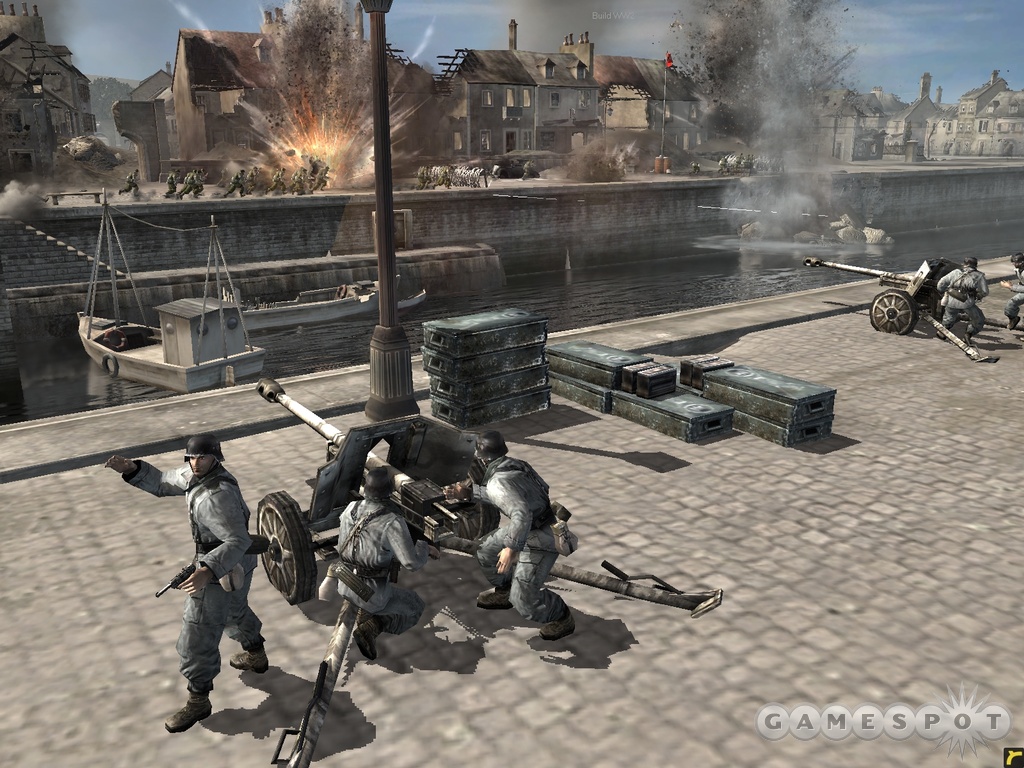E3 06: Company of Heroes Exclusive Preshow Hands-On
We got sent to Relic to get an exclusive hands-on of Company of Heroes, one of the most promising real-time strategy games of the year.
It's easy to want to dismiss Company of Heroes as yet another World War II-based real-time strategy game. Don't. With its incredible scenes of combat and destruction, the latest strategy game from Relic Entertainment and publisher THQ was easily one of the most promising games that we saw at last year's Electronic Entertainment Expo. This year, it's safe to say that Company of Heroes will blow people away. We know because we recently had a chance to travel to Relic's offices for an exclusive hands-on play session of the game, and we came away impressed with what Company of Heroes has to offer.
In Company of Heroes, Relic wants to let you command infantry squads and vehicles on an incredibly realistic battlefield. As lead designer Josh Mosqueira tells us, the company's goals were: "real soldiers, real battlefields, and real war." To do this, Relic is introducing what it calls "environmental strategy," which promises to make you rethink real-time strategy altogether. In most real-time strategy games, you can go only where the level designers want you to go, because you can't really affect the environment. But if you have a bazooka capable of blowing up a tank, why can't it blow a hole in the wall that's blocking your progress? Company of Heroes will let you knock down that wall, and pretty much everything else, since all objects in the game have physical properties and operate according to the laws of physics (or, as Relic likes to put it, Hollywood physics). This isn't the same thing as buildings exploding if you knock their hit points down to zero, like in so many other games. The damage done in Company of Heroes is specific and scales depending on the weapon that inflicted it. Bullets will bounce off a brick wall, but a tank shell will blast a hole or tear a chunk out of that same wall. And this idea changes everything, because with a dynamic battlefield you have so many more options available to you. More importantly, your soldiers will recognize this, as well.
"We really want players to feel like they're commanding real soldiers," Mosqueira says. That means Relic is working to deliver artificial intelligence that will make it so that each soldier uses real-world tactics and that they react to the ever-changing nature of the battlefield. You can see this when a squad moves up a street, cautiously and in formation. If the squad comes under fire, the individual soldiers find whatever cover is available on their own and begin to return fire, without your having to give them that order. Or if they come under artillery fire, they'll automatically scatter out of the barrage area. The idea is that you don't need to micromanage your troops, which lets you focus on the bigger picture of managing the battle.

If you put the destructible environments and smart AI together, it's clear why the designers at Relic are so excited. Mosqueira told us about an incident when he barricaded a squad of US Army Rangers in a building. Though armed with a bazooka, the Rangers couldn't get a shot off at a German tank prowling about in the street outside because the building didn't have any windows on that side. Never fear, because another Ranger squad shot at the tank with its bazooka, missed, and accidentally blew a hole in the side of the building. The Rangers inside then recognized that the environment had changed and lined up a shot at the tank with their bazooka. It's this kind of behavior that can make it feel like you're leading real men in battle, and Mosqueira told us that Company of Heroes is the first real-time strategy game that let him use all the tactics he had learned while serving as an infantryman in the Canadian army. That also includes the concept of retreating. Units in Company of Heroes can gain experience over time, so it'll be important to try to preserve your elite units so they can fight another day. There's even a handy fallback order you can issue to a squad, and it'll disengage and fall back to the base to heal up and restore any losses.
Like an earlier Relic game, Warhammer 40,000: Dawn of War, Company of Heroes is going to be focused more on the action and less on base building and resource gathering. You'll still create a rear base, which lets you summon reinforcements in the form of infantry squads and vehicles, as well as research various upgrades, such as sticky mines for infantry. The resource system, on the other hand, will introduce a nice twist on the one found in Dawn of War. You won't chop wood or mine for ore in Company of Heroes. Instead, you must capture strategic points on the map to generate resources. The twist is that the map is divided into sectors, and some sectors give you access to different resources. Seize a fuel sector, and you start accumulating fuel, which can be used to purchase tanks and other vehicles. A munitions sector supplies munitions points, which are used whenever your units fire their weapons, but they're also used to purchase upgrades. Finally, a manpower sector will generate manpower points, which are used to summon infantry and other reinforcements. It doesn't take much to realize just how valuable these sectors can be, particularly fuel sectors.

In addition to sectors and supply points, there's a new concept of units being "in supply." If you switch the view to the tactical map, which is a high-level overview of the entire battlefield, you'll see where the front lines are, as well as whoever controls each sector. If your units are fighting in a sector that has a clear connection to your other sectors, they're considered "in supply," which means that you can upgrade those units, and they also have the ability to use special abilities. You can build only in sectors that are in supply, so if you want to construct an observation post or a machine-gun nest to secure a strategic point (this also has the added benefit of generating resources faster in that sector), then you need to make sure it's in supply--not to mention, any resource sectors that are cut off won't contribute to your economy. This adds depth to the battlefield, as it'll be possible for a losing side to try to send units deep into an enemy's rear and seize its key resource sectors, as well as cut off its frontline units. And this also turns Company of Heroes into a deeper game. Maps will be large enough to give you room to maneuver, so it'll be up to you to decide where to attack, where to defend, and where to try to sneak up on the enemy.
Saving Private You
We had a chance to see the dynamic combat and depth in Company of Heroes for ourselves by playing a multiplayer engagement several times to see how a battle can unfold differently depending on the tactics you use, what your enemy does, and the chain of events. In one engagement, we got to an important objective first and immediately began building defenses around it using our engineers. Mines were laid in the approaches to the objective, while barbed wire was put down to force approaching infantry to go the long way around, making them easy targets for a machine-gun nest. Finally, a line of sandbags provided some makeshift cover for our infantry, since the objective point was on an elevated railway that left them otherwise exposed. The first time we fought this battle, things went according to plan and we chopped up the enemy. The second time, however, our opponent adapted to our tactics and sent snipers to take out our infantry. Since snipers can snipe from a distance, it was impossible for the dug-in infantry to see them, let alone take them out. So we sent a scout jeep, armed with a 50-caliber machine gun, behind enemy lines to quickly take care of the sniper problem. Then the enemy sent in tanks, and the battle escalated rapidly from that point, with both sides pouring reinforcements in to maintain pressure. 
We fought this battle again, but this time concentrated on another sector on the map, where we battled for an all-important fuel depot that could spell the difference between victory and defeat. This sector was heavily developed, with large factories and buildings to barricade infantry squads, snipers, and antitank teams in. It's also a good place to deploy mortar teams, since they can arc their rounds over the top of buildings, keeping them out of sight. This proved to be a slugfest of a battle as well, as tanks, artillery, and satchel charges shattered pretty much every building around the objective. It's not all random chaos, though, as you'll still have to use smart tactics to win. Take armor, for example. Depending on the side that you play, you'll need to employ tanks differently. Germany had some of the best tanks of the war, far outclassing American armor. On the other hand, the United States could churn out far more tanks than Germany. This is represented in the game: A Sherman is dead meat in a one-on-one duel with a Panzer; however, those playing the US side will be able to summon more tanks than the Germans, and a valid historical tactic is to sacrifice one Sherman against a Panzer while sending two other Shermans to hit the German from the sides or the rear, where the armor is weaker.
There's a considerable amount of replayability built into Company of Heroes just by the way the battles unfold. And that's before Relic introduced the concept of the Company Commander system, which lets you tailor the tech tree toward your play style, allowing you to focus on the armor, infantry, or airborne combat arms. Basically, you will slowly gain experience levels depending on your troops' performance in battle. The first time you gain a level, you can choose which tech tree you want to follow: armor, infantry, or airborne. Subsequent levels will then let you unlock special abilities unique to each combat arm, such as the American ability to rapidly replace tank losses. When this specific power is used, if you lose a tank, it'll be instantly replaced back at base. This power is temporary, however, but you can imagine that you'll want to save it for use during a big tank battle. And if you play through the game specializing in armor technologies, you can play the game again focusing on airborne technologies for a different experience.
Company of Heroes will ship with both a single-player campaign and a multiplayer suite, though details about the campaign remain scarce for now. We do know that Relic is going in an interesting direction with the multiplayer portion of Company of Heroes, as the game will only ship with team modes. Relic says that its research indicates that 80 to 90 percent of online real-time strategy players play co-op games in the form of two-versus-two, three-versus-three, and four-versus-four games, so Company of Heroes will support up to eight players in two teams. We played in a number of two-versus-two matches with members of the development team and got a feel for how teamwork comes into play. You can rush to one another's aid, as well as drop markers on the map indicating what you want your teammate to do. An important part of multiplayer is what Relic calls "live together, die together." This is a way to eliminate the problem seen in other real-time strategy games when one side concentrates on a single player early in a match, and that player is quickly eliminated and can do nothing but sit around or quit. In "live together, die together," players will respawn until someone wins the game by knocking out all the players on an opposing team or completes the mission objectives.
As impressive as the gameplay is, there's equal attention being paid to the visuals. The action looks incredibly cinematic at times, and it's possible to flinch when you see a cloud of shrapnel suddenly explode over a squad's head, or you watch bodies hurl through the air from the force of explosions. Everything in Company of Heroes looks good, from the animations--the game is capable of piecing together thousands of separate motion-captured animations to create incredibly realistic movements and scenes--to the sheer sense of mayhem on the screen. Buildings are gutted by explosions, wooden cover is shredded by machine guns, and even cow carcasses are fair game. It's safe to say that the visuals may be the best seen in a real-time strategy game yet. The good news, according to Mosqueira, is that the graphics are quite scalable and that "you will still get a really awesome experience" on a lower-end system, though you may not get all the eye candy seen in the screenshots. Company of Heroes will ship with native support for DirectX 10, the upcoming version of Microsoft's gaming API to be featured in Windows Vista. Don't worry about upgrading immediately, though, because the game will also ship with native support for the existing standard, DirectX 9.

The sounds in the game are also incredible, and we were reminded of that scene in Saving Private Ryan when the paratroopers hear the ominous rumbling of German tanks long before they see them. We got the same feeling playing Company of Heroes--you'll often hear things long before you see them. And speaking of movies, you'll be able to create your own battlefield epics in Company of Heroes thanks to the built-in record feature that will let you play back a battle from any angle. Relic will even ship the game with some kind of moviemaker tool, so you can put together your own movies. We imagine that would-be Spielbergs will have a lot of fun playing around with this, but even if you don't tinker around with moviemaking, Company of Heroes promises to be an incredibly cinematic experience. This is a game that looks to combine beautiful graphics, destructible environments, and smart AI to create the most intense World War II strategy game to date. We'll find out how well it all comes together when Company of Heroes ships later in the year.
Got a news tip or want to contact us directly? Email news@gamespot.com
Join the conversation